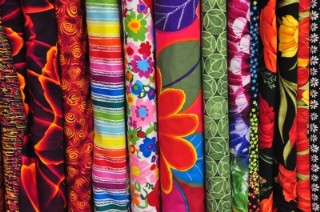Quilting Fabric
Various types of quilting fabric are used in patchwork, appliqué or quilting. The different types hold different properties which will be discussed in detail below.
Calico represents a plain-woven cotton textile which is fairly strong and durable. It is presented as having different weights and its normal colors are white and natural with darker spots, it also comes in many lovely prints.
Corduroy, or as it is also known fine-wale corduroy, represents a plain-woven fabric which has vertical ribbing. Because it frays easily, it is only used in appliqué or when dealing with larger patch pieces.
Cotton represents probably the most used of all the quilting fabrics around. It is easy to handle with yet it doesn't deteriorate easily. It also comes in various colored printings, plain or patterned. Its characteristics make it ideal for patchwork fabrics.
Felt is a woolen material, which is not pre-weave. Because of this, the fibers are heated and compressed with moisture. Due to the fact that is not pre-weave, this material shrinks easily and it cannot be handled very well by quilters. Since it also needs frequent washing, felt is a suitable material for appliqué.
Gingham represents a quilting fabric made from dyed cotton yarn which displays alternating strips of both white and colored threads. It is commonly known as checkered pattern.
Lawn represents a type of fine cotton or a blended fabric. It is sold either plain or in prints.
Linen represents a textile made from the fibers of the flax plant. It makes wrinkles and frays easily but nonetheless, it is still used as ground fabrics. It must be preshrunk.
Muslin represents a type of finely woven cotton fabric which is mainly used to provide backing for the quilts or in the appliqué work.
Organdy represents a type of starched cotton especially used in shadow working. Organza represents a silken woven fabric which has special properties. For one thing, it gives the impression of being diaphanous because it gives off effects of metallic iridescence. Since it is made from synthetic blends, it is perfect for shadow working or appliqué. In other occasions, it is even used in delicate patchwork.
The PVC represents a type of material made from plastic cotton-backed cloths. Because it lacks flexibility in handling, it is especially difficult to handle. Therefore, PVC is only used in appliqué or patchwork.
Sateen represents a soft, beautiful type of fabric because it has a certain shiny luster to it. This special property makes it wonderful for appliqué.
Satin represents a fabric made from cotton, synthetics or silk that also has a shiny luster to it. Similarly to the sateen, it is primarily used in appliqué projects.
Silk represents a fabric that is created naturally by silk worms, through the fibers that they produce which are then sewn together to make silk. Silk is especially useful in almost any type of quilting work and comes in a variegated choice of color, sizes, weights and patterns.
Shantung fabric represents an irregularly thick fabric woven from yarn. Because of the irregular fabric it is made of, shantung fabric has an uneven surface. Shantung is employed in patchwork and quilting.
Taffeta is a fabric which comes in two tones. It is produced from plain woven fabrics and is useful in appliqué and minor patchwork.
Velvet is a closely woven fabric which has a dense surface. It is mainly utilized for patchwork but you must bear in mind that the nap should be oriented versus the same direction with patchwork, especially if you want to use velvet for crazy patchwork. Using velvet for quilting fabric makes a very heavy, warm quilt.
Voile represents a finely woven fabric which is used mainly in shadow work. Wool comes from woven fleece and represents a material that needs special handling. For one thing, it doesn't wash well and it is recommended to use it in appliqué, provided that it is not lightweight. This type of wool, the lightweight, can be instead used in patchwork.




